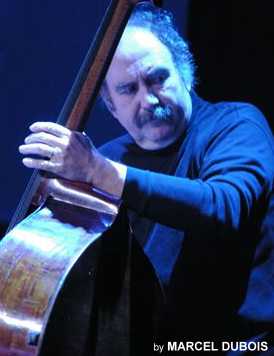Featured artists:
MICHEL DONATO & GUILLAUME BOUCHARD

Who
in their right musical mind would choose to listen to a CD featuring
two upright acoustic basses? Who listens to bass anyway, besides
bass players? The mere thought of a bass solo makes me wish that
Canada would relax its gun laws. For the politically astute listener,
the low solo -- the “Take Five” within the song --
signals when drinks should be ordered and bursting kidneys emptied.
I was
in this beyond-reproach, non-judgmental state of mind when I entered
the Upstairs Jazz Club (Montreal) for the launching of Happy
Blue, with Michel Donato on upright bass and Guillaume Bouchard
on upright bass. The duo performed a mix of original compositions
and standards, reflecting the CD’s 12 to 5 ratio.
In making
their case that the bass can function as a lead instrument, most
bassists will concede that even the sophisticated ear finds it
difficult to render meaningful the interval between notes played
in the lower ranges, that what the average listener is looking
for is a general ground swell of sound -- not to be confused with
melody – that discreetly carries and stabilizes the music.
That being the case, what persuaded Donato and Bouchard to think
their low-noted visions were sufficiently arresting and inventive
that listeners would be suddenly drawn to soundscapes the ear
normally refuses?
On most of the selections, we find Donato providing the support
while Bouchard plays either the straight or improvised melody
on the instrument’s highest range. They wisely decided to
separate their parts as much as the instrument allows so listeners
might better distinguish between the supporting and lead roles.
Implicit in their decision is that the bass, in the right hands,
is at least as suitable as the piano, guitar or wind instrument
in producing the desired emotive effects.
Since
there is no getting around the structurally predetermined range
and tone of the instrument and the moods with which it is most
often associated, what can we say about the upright bass’s
generic acoustic sound? Unlike the guitar or the piano, it takes
a lot of work (and scabs to die for) to produce a bass note: sometimes
two fingers are used in the pluck. Compared to the guitar and
violin, bass strings are unwieldy and wound thick. The notes themselves
seem to come into being with great difficulty, as if out of some
deep captivity or enclosure, or gut of an ancient mammal saying
no to its extinction. And when the note finally escapes, it’s
with a muted burp-like thud that vibrates between a groan and
drone. Were it not for its amalgamation with electronics and amplification,
the bass note would remain permanently in thrall to its opacity
and thickness. Which is to say, if I were a chirping bird on the
wing, I would not perform the rites of spring to the sound of
the bass.
Most
players are attracted to the bass for its central position among
other instruments and for its crucial role in balancing and buoying
a structure of sound that is in constant flux. When a bass player
dreams of success, it’s always in a group context: he makes
support, not melody, his obsession. Since bassists have traditionally
thrived in a supporting role, it’s only natural we take
notice when they rebel against that expectation.
To better
evaluate the Donato and Bouchard collaboration, I chose to fully
concentrate on a song I’m very familiar with -- Django’s
Reinhardt’s "Nuages" -- and asked what new insights
and revelations they brought to it, and if there was enough there
to make me want to listen again, and if again and again, why their
version compared to, for example, Biréli Lagrène’s
or Stéphane Grappelli’s.
So far,
I haven’t found the stairway to Donato & Bouchard heaven,
but I’m thankful for having had the exceptional opportunity
to engage their 20,000 leagues deep sound on its own terms, if
only to discover my limitations as a listener.
What
is not in dispute is their first rate musicianship. Donato has
played with the best (Peterson, Evans, Mulligan) while Bouchard’s
compositions are refreshingly apposite on an instrument that challenges
the prevailing protocols of sound. They have entered new visions
of the upright bass into the public domain knowing full well the
public will have the last word. And if we grant that both musicians
are sincerely responding to a highly specialized calling, they
must grant that being chosen does not necessarily follow from
being called.
From
Happy Blue, listen to Michel Donato and Guillaume Bouchard
perform "Nuages."